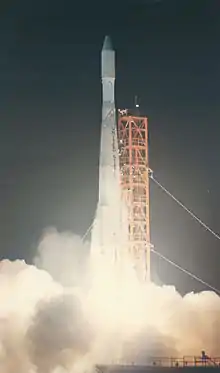Delta E
The Delta E, or Thor-Delta E was an American expendable launch system used for twenty-three orbital launches between 1965 and 1971. It was a member of the Delta family of rockets.
 Launch of a Delta E with Pioneer 6 | |
| Function | Expendable launch system |
|---|---|
| Country of origin | United States |
| Launch history | |
| Status | Retired |
| Launch sites | Cape Canaveral LC-17 Vandenberg SLC-2E |
| Total launches | 23 |
| Success(es) | 23 |
| First flight | 6 November 1965 |
| Last flight | 1 April 1971 |
The first stage was a Thor missile in the DSV-2C configuration, and the second stage was the Delta-E, which was derived from the earlier Delta-A. Three Castor-1 solid rocket boosters were clustered around the first stage. Two different solid-fuel upper stages were available; an Altair-2 was used on the baseline version, however this could be replaced with an FW-4D to increase performance. A Delta E with the FW-4D upper stage was designated Delta E1. Six flights used the Delta E configuration and seventeen used the Delta E1.
Delta E rockets were launched from Cape Canaveral Air Force Station Launch Complex 17 and Vandenberg Air Force Base Space Launch Complex 2E. All 23 flights were successful. On December 16 1965, a Delta E launched the Pioneer 6 space probe.[1][2]
References
- Wade, Mark. "Delta". Archived from the original on 2008-07-24.
- Krebs, Gunter. "Thor Family". Gunter's Space Page. Archived from the original on 2007-08-06. Retrieved 2021-12-21.
